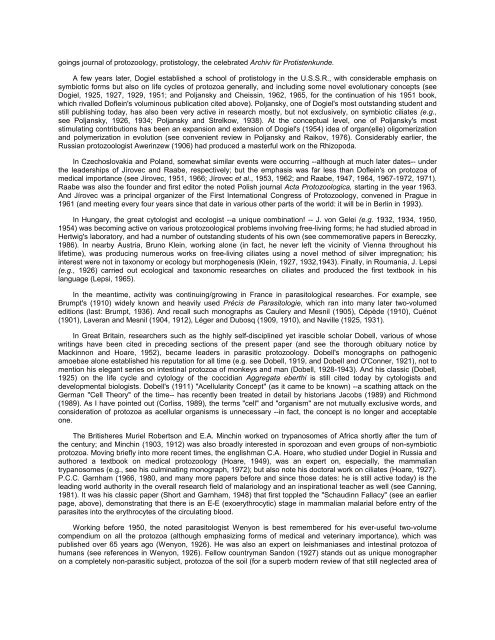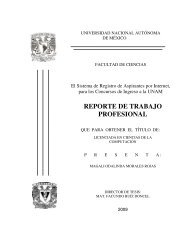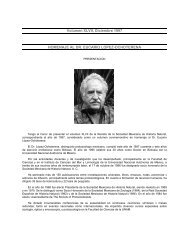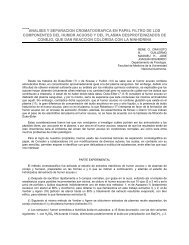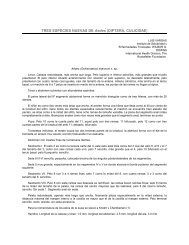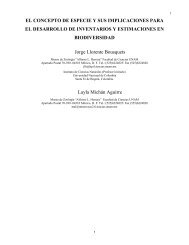Imprimiendo - Revista de la Sociedad Mexicana ... - Ciencias,UNAM
Imprimiendo - Revista de la Sociedad Mexicana ... - Ciencias,UNAM
Imprimiendo - Revista de la Sociedad Mexicana ... - Ciencias,UNAM
You also want an ePaper? Increase the reach of your titles
YUMPU automatically turns print PDFs into web optimized ePapers that Google loves.
goings journal of protozoology, protistology, the celebrated Archiv für Protistenkun<strong>de</strong>.A few years <strong>la</strong>ter, Dogiel established a school of protistology in the U.S.S.R., with consi<strong>de</strong>rable emphasis onsymbiotic forms but also on life cycles of protozoa generally, and including some novel evolutionary concepts (seeDogiel, 1925, 1927, 1929, 1951; and Poljansky and Cheissin, 1962, 1965, for the continuation of his 1951 book,which rivalled Doflein's voluminous publication cited above). Poljansky, one of Dogiel's most outstanding stu<strong>de</strong>nt andstill publishing today, has also been very active in research mostly, but not exclusively, on symbiotic ciliates (e.g.,see Poljansky, 1926, 1934; Poljansky and Strelkow, 1938). At the conceptual level, one of Poljansky's moststimu<strong>la</strong>ting contributions has been an expansion and extension of Dogiel's (1954) i<strong>de</strong>a of organ(elle) oligomerizationand polymerization in evolution (see convenient review in Poljansky and Raikov, 1976). Consi<strong>de</strong>rably earlier, theRussian protozoologist Awerinzew (1906) had produced a masterful work on the Rhizopoda.In Czechoslovakia and Po<strong>la</strong>nd, somewhat simi<strong>la</strong>r events were occurring --although at much <strong>la</strong>ter dates-- un<strong>de</strong>rthe lea<strong>de</strong>rships of Jírovec and Raabe, respectively; but the emphasis was far less than Doflein's on protozoa ofmedical importance (see Jírovec, 1951, 1966; Jírovec et al., 1953, 1962; and Raabe, 1947, 1964, 1967-1972, 1971).Raabe was also the foun<strong>de</strong>r and first editor the noted Polish journal Acta Protozoologica, starting in the year 1963.And Jírovec was a principal organizer of the First International Congress of Protozoology, convened in Prague in1961 (and meeting every four years since that date in various other parts of the world: it will be in Berlin in 1993).In Hungary, the great cytologist and ecologist --a unique combination! -- J. von Gelei (e.g. 1932, 1934, 1950,1954) was becoming active on various protozoological problems involving free-living forms; he had studied abroad inHertwig's <strong>la</strong>boratory, and had a number of outstanding stu<strong>de</strong>nts of his own (see commemorative papers in Bereczky,1986). In nearby Austria, Bruno Klein, working alone (in fact, he never left the vicinity of Vienna throughout hislifetime), was producing numerous works on free-living ciliates using a novel method of silver impregnation; hisinterest were not in taxonomy or ecology but morphogenesis (Klein, 1927, 1932,1943). Finally, in Roumania, J. Lepsi(e.g., 1926) carried out ecological and taxonomic researches on ciliates and produced the first textbook in his<strong>la</strong>nguage (Lepsi, 1965).In the meantime, activity was continuing/growing in France in parasitological researches. For example, seeBrumpt's (1910) wi<strong>de</strong>ly known and heavily used Précis <strong>de</strong> Parasitologie, which ran into many <strong>la</strong>ter two-volume<strong>de</strong>ditions (<strong>la</strong>st: Brumpt, 1936). And recall such monographs as Caulery and Mesnil (1905), Cépè<strong>de</strong> (1910), Cuénot(1901), Laveran and Mesnil (1904, 1912), Léger and Dubosq (1909, 1910), and Naville (1925, 1931).In Great Britain, researchers such as the highly self-disciplined yet irascible scho<strong>la</strong>r Dobell, various of whosewritings have been cited in preceding sections of the present paper (and see the thorough obituary notice byMackinnon and Hoare, 1952), became lea<strong>de</strong>rs in parasitic protozoology. Dobell's monographs on pathogenicamoebae alone established his reputation for all time (e.g. see Dobell, 1919, and Dobell and O'Conner, 1921), not tomention his elegant series on intestinal protozoa of monkeys and man (Dobell, 1928-1943). And his c<strong>la</strong>ssic (Dobell,1925) on the life cycle and cytology of the coccidian Aggregata eberthi is still cited today by cytologists and<strong>de</strong>velopmental biologists. Dobell's (1911) "Acellu<strong>la</strong>rity Concept" (as it came to be known) --a scathing attack on theGerman "Cell Theory" of the time-- has recently been treated in <strong>de</strong>tail by historians Jacobs (1989) and Richmond(1989). As I have pointed out (Corliss, 1989), the terms "cell" and "organism" are not mutually exclusive words, andconsi<strong>de</strong>ration of protozoa as acellu<strong>la</strong>r organisms is unnecessary --in fact, the concept is no longer and acceptableone.The Britisheres Muriel Robertson and E.A. Minchin worked on trypanosomes of Africa shortly after the turn ofthe century; and Minchin (1903, 1912) was also broadly interested in sporozoan and even groups of non-symbioticprotozoa. Moving briefly into more recent times, the englishman C.A. Hoare, who studied un<strong>de</strong>r Dogiel in Russia andauthored a textbook on medical protozoology (Hoare, 1949), was an expert on, especially, the mammaliantrypanosomes (e.g., see his culminating monograph, 1972); but also note his doctoral work on ciliates (Hoare, 1927).P.C.C. Garnham (1966, 1980, and many more papers before and since those dates: he is still active today) is theleading world authority in the overall research field of ma<strong>la</strong>riology and an inspirational teacher as well (see Canning,1981). It was his c<strong>la</strong>ssic paper (Short and Garnham, 1948) that first toppled the "Schaudinn Fal<strong>la</strong>cy" (see an earlierpage, above), <strong>de</strong>monstrating that there is an E-E (exoerythrocytic) stage in mammalian ma<strong>la</strong>rial before entry of theparasites into the erythrocytes of the circu<strong>la</strong>ting blood.Working before 1950, the noted parasitologist Wenyon is best remembered for his ever-useful two-volumecompendium on all the protozoa (although emphasizing forms of medical and veterinary importance), which waspublished over 65 years ago (Wenyon, 1926). He was also an expert on leishmaniases and intestinal protozoa ofhumans (see references in Wenyon, 1926). Fellow countryman Sandon (1927) stands out as unique monographeron a completely non-parasitic subject, protozoa of the soil (for a superb mo<strong>de</strong>rn review of that still neglected area of


